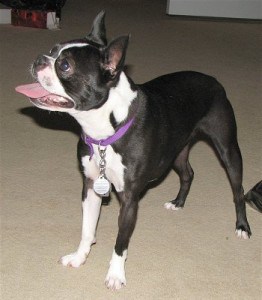Hi and Welcome Everyone!
This is Sharda with Boston Terrier newsletter!
The Boston Terrier is perhaps as true blue an American as Uncle Sam, Stars and Stripes or apple pie. In fact, it is one of the few dog breeds that are entirely native to the United States. So here’s a bit of Boston Terrier History facts I wanted to share with you!
This breed was first born and bred in Beantown, a seaport of Boston in the North eastern United States in the 1870s.
It was a cross between an English Bulldog and a white English Terrier or Hooper’s Judge.
This breed was originally bred to take part in dog fighting pits in the Boston, Massachusetts area.
You would be amazed to know that this cross also produced breeds such as the American Staffordshire Terrier, Staffordshire Bull Terrier, American Pit Bull Terrier and Bull Terrier.
Historical records testify that this breed was originally developed to promote the cruel 18th century “sport” of dog fighting. Robert Cooper introduced it in the Colonies.
We now know that the first American ancestor of this breed was actually a mix between a bulldog and a terrier.
When it was further bred with the French bulldog and the English terrier, the result was the Boston Terrier.
But it will surprise you to know that the name “terrier” is really a misleading since the Boston Terrier was never developed for rat hunting, unlike the true terriers.
But the Boston Terrier Pets, as we know it, is acknowledged to be a good fighter, due largely to its muscular build and short snout.
Historically, this breed is known by many names, some of them being the “American Gentleman” and “Boston Bulls”, though they were originally called the Round Heads or Bull Terriers.
Though the first time the English Bulldog and Terrier were crossed in England, the breed really achieved the level of refinement as we know it today, in the United States when some members of this hybrid breed were shipped there.
This is why it is affectionately called the Bull Terrier.
In 1889, 30 Boston owners established the American Bull Terrier Club. They also bred and exhibited their dogs as Round Heads or Bull Terriers until the owners and fanciers of this breed took objection to the name being similar for a breed that was so radically different from both of their breeds.
Rather than fight back, the newly formed club decided to change its name to the Boston Terrier Club of America (BTCA).
Later, this was shortened to the Boston Terrier, and in 1893 the American Kennel Club recognized the breed and accepted the club as a member.
By 1915, the Boston Terriers had stabilized into a breed of repute and was extremely popular in the United States.
Amongst the top 20 breeds of the time, this one was the No. 1, of a total of 22,127. They repeated their No. 1 status in 1920 and 1930 and remained among the top 10 until 1960 when they lost their coveted position—one they have never been able to regain since.
However, this breed’s popularity remains unchanged: something that can be proved by the AKC registering 17,738 individual Boston Terriers and managing 10,019 litters by 1999.
Though at first, its color and markings weren’t important, by the early 1900s, the Boston Terrier’s singular markings had evolved into its fundamental breed characteristic. Come 1935, this was the most popular breed in America, which has continued to retain its overall breed quality.
Originally, Boston Terriers weighed a little over 20 kg it was soon bred down to size.
Today, we also know it for its bullish expression, and compact, muscular physique.
It has a short, wide muzzle leading on to an ample black nose. It has dark, large round eyes setwide apart.
It also has fine, erect ears that give it a very vigilant air. Its broad, flat head is wrinkle-free.
It has a slightly arched neck leading on to a broad chest.
If its limbs are straight and muscular, it also has a short but glistening coat, though very fine textured that you can often see in brindle and white, or black and white, though rarely you might also spot some in brown and white.
That’s it for today.
I hope that you learned a lot from today’s Boston Terrier newsletter.
All the best and take care
Warmly,
Sharda Baker

